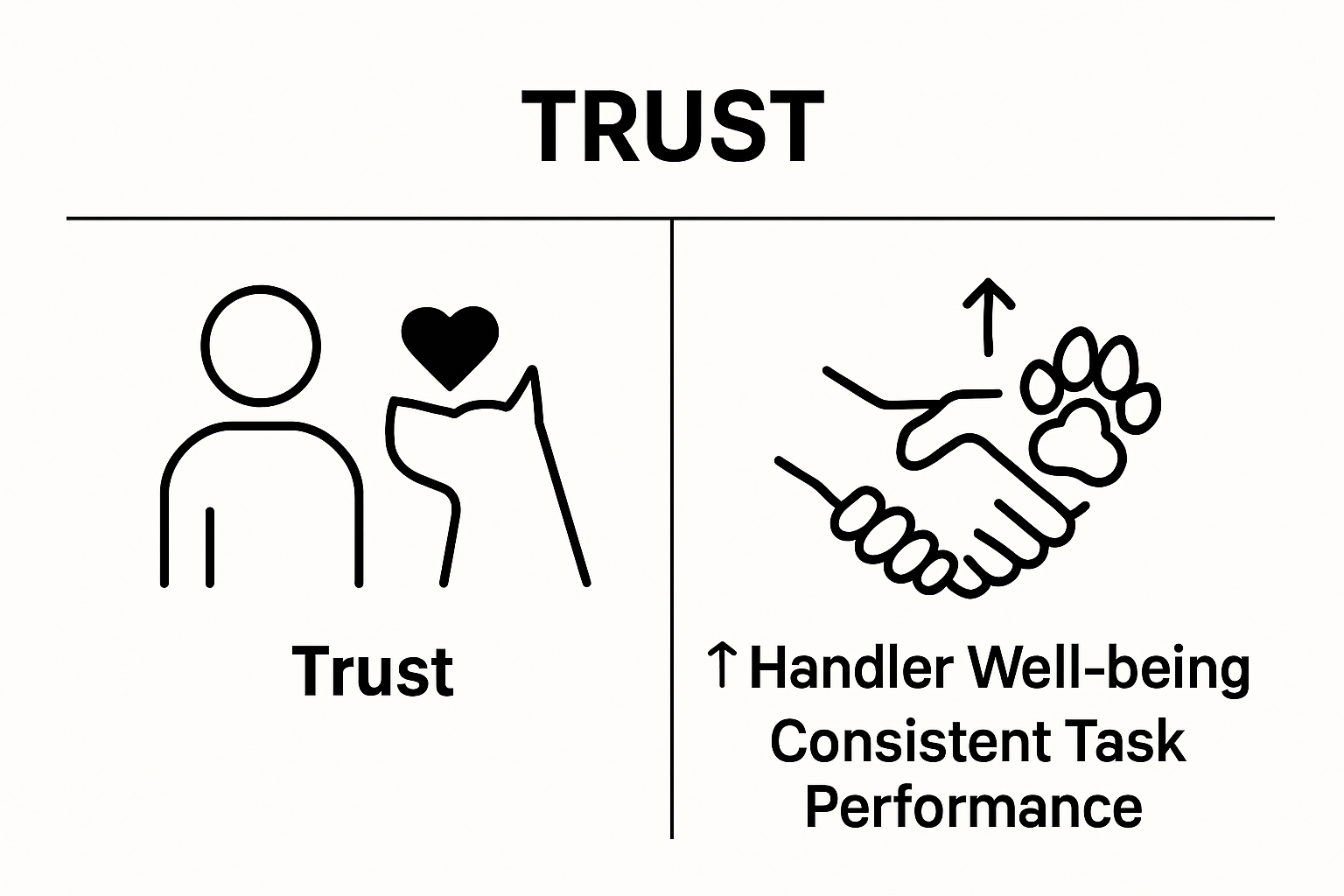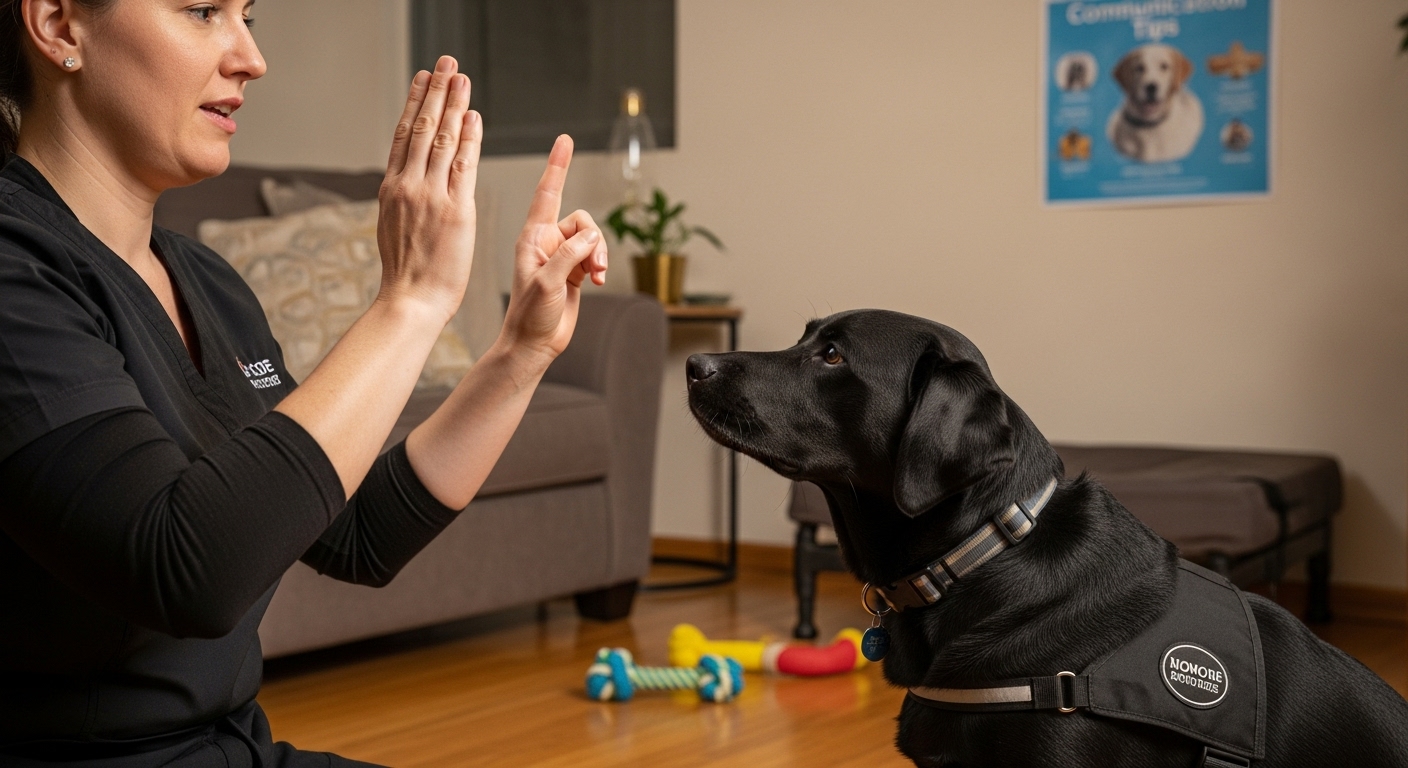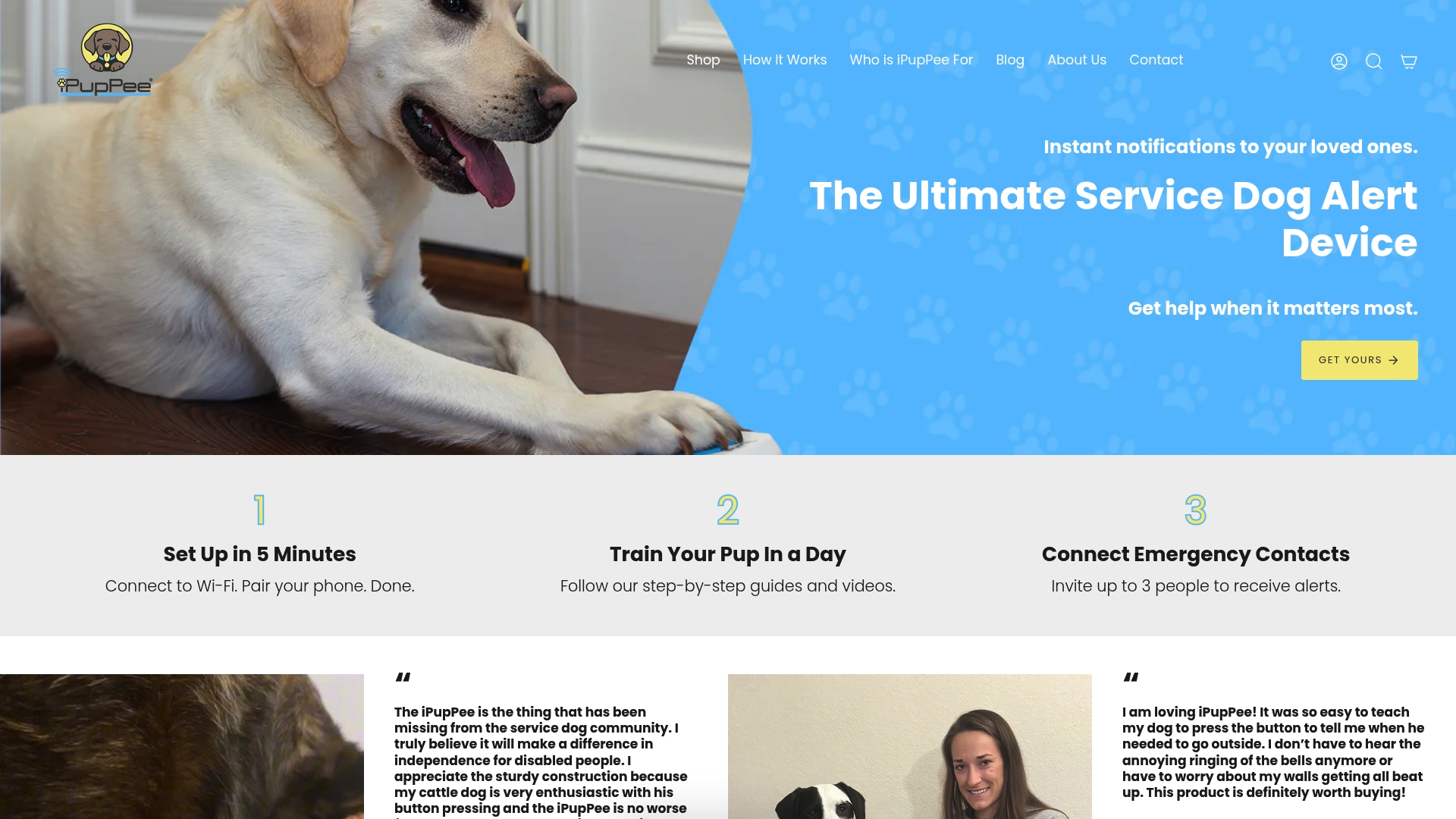Building a real partnership with a service dog is about way more than just teaching tricks or following commands and it comes with outcomes that might surprise you. Most people expect a working relationship, but service dogs actually create a bond so powerful that handlers report improved well-being and higher confidence in daily life. This connection runs so deep that it can even allow dogs to pick up on changes in their handler’s health before medical devices can, changing how support is given in everyday moments.
Table of Contents
- What Is Service Dog Bonding And Why It Matters?
- The Importance Of Trust In Service Dog Relationships
- Building Effective Communication With Your Service Dog
- Real-World Applications Of Service Dog Bonding Techniques
- Challenges And Solutions In Developing A Strong Bond
Quick Summary
| Takeaway | Explanation |
|---|---|
| Trust is essential for service dog bonding | Building trust improves communication and responsiveness between the handler and the service dog. |
| Effective communication relies on nonverbal signals | Handlers should understand and use body language to enhance communication with their service dog. |
| Deep emotional connections lead to better support | A stronger bond allows service dogs to perform tasks with greater accuracy and empathy towards their handlers’ needs. |
| Anticipatory responses are crucial in emergencies | Well-bonded service dogs can intuitively respond to medical changes and anxiety episodes. |
| Overcoming bonding challenges requires strategic approaches | Identifying individual obstacles and adapting methods can strengthen the relationship between handler and dog. |
What is Service Dog Bonding and Why it Matters?
Service dog bonding represents a profound emotional and functional connection between a handler and their assistance animal. This relationship goes far beyond basic pet ownership, transforming into a collaborative partnership that fundamentally supports an individual’s daily functioning and independence.
The Deep Psychological Foundation of Service Dog Connections
At its core, service dog bonding is about developing mutual trust, communication, and interdependence. Unlike typical pet relationships, service dog partnerships are built on intricate understanding and synchronized responses. A service dog learns to read their handler’s subtle cues, anticipate needs, and provide targeted support across physical and emotional domains.
Groundbreaking research on human-animal bonds demonstrates that strong service dog connections directly correlate with improved handler well-being. These relationships are characterized by:
- Heightened non-verbal communication
- Synchronized emotional states
- Reciprocal understanding of individual needs
Why Emotional Connection Matters in Functional Support
The bond between a service dog and handler is not just emotional but critically functional. A deeply connected service dog can more accurately detect medical changes, provide stability, interrupt anxiety episodes, and execute complex tasks with precision. This connection transforms an animal from a trained assistant into a genuine life partner.
For individuals with disabilities, a well-bonded service dog represents more than assistance — it represents freedom, confidence, and enhanced quality of life. By reading our guide on service dog handler tips, handlers can learn strategies to deepen these remarkable connections and maximize their partnership’s potential.
The Importance of Trust in Service Dog Relationships
Trust forms the cornerstone of successful service dog partnerships, representing a complex psychological and behavioral connection that transcends traditional human animal interactions. Unlike typical companion animal relationships, service dog trust requires extraordinary depth and precision.
Foundations of Trust Development
Service dog trust emerges through deliberate, consistent interactions where both handler and dog learn to communicate seamlessly. Mutual understanding becomes the primary language, where non-verbal cues, emotional synchronization, and predictable responses create a robust foundation. This intricate process involves developing:
- Reliable task performance
- Consistent emotional regulation
- Predictable response patterns
Research published by Purdue University demonstrates that trust between service dogs and handlers directly correlates with enhanced psychological well-being. The handler learns to trust the dog’s capabilities, while the dog develops an intuitive understanding of the handler’s unique needs.

Trust as a Functional Communication System
Trust in service dog relationships operates as a sophisticated communication system. A well-bonded service dog interprets subtle physiological and emotional signals that might be imperceptible to humans. This profound connection allows for preemptive support during medical episodes, anxiety attacks, or mobility challenges.
Understanding these nuanced interactions requires specialized knowledge. Our comprehensive guide to service dog training provides deeper insights into developing this extraordinary partnership. The trust between a service dog and handler represents more than a training outcome — it is a dynamic, living relationship where both participants continuously learn, adapt, and support each other.
Building Effective Communication with Your Service Dog
Communication between a service dog and handler represents a sophisticated, multilayered interaction that transcends traditional verbal commands. This nuanced exchange involves complex behavioral signals, emotional attunement, and precise mutual understanding that enables seamless collaboration.
The Language of Nonverbal Signals
Effective communication begins with understanding canine body language. Service dogs rely extensively on subtle physical cues, reading their handler’s posture, facial expressions, and energy levels with remarkable precision. Handlers must learn to communicate not just through words, but through consistent, intentional body movements and emotional states.
Key elements of nonverbal communication include:
- Consistent hand signals
- Controlled body posture
- Predictable emotional responses
- Deliberate eye contact
Research from the University of Massachusetts Amherst highlights that successful service dog communication requires comprehensive training focused on mutual understanding and responsive interactions.
Developing a Shared Communication Protocol
Building a robust communication system demands patience, consistency, and specialized training.
Handlers must develop a personalized communication framework that adapts to their specific needs and the dog’s unique capabilities. This involves creating clear, repeatable signals that the dog can reliably interpret across various environments and stress levels.
Learn more about training service dog signals to refine your communication strategies. The goal is not mere obedience, but creating a dynamic partnership where both handler and dog can anticipate and respond to each other’s needs with intuitive precision.
Real-World Applications of Service Dog Bonding Techniques
Service dog bonding techniques extend far beyond theoretical training, manifesting in profound real-world scenarios where these remarkable animals provide critical support across diverse challenging environments. The practical application of bonding represents a sophisticated dance of anticipation, trust, and instantaneous response.
Navigating Complex Social and Medical Environments
Service dogs function as living, breathing support systems that adapt dynamically to their handler’s unique needs. In medical settings, for instance, a well-bonded service dog can detect subtle physiological changes indicating potential health risks before traditional medical instruments might recognize them. This extraordinary capability stems from deep emotional attunement and consistent training that transforms communication from instruction-based to intuitive.
Key practical applications include:
- Medical alert for seizures
- Anxiety interruption techniques
- Mobility assistance navigation
- Emergency response signaling
Research from Frontiers in Veterinary Science demonstrates that positive reinforcement training methods significantly enhance the human-animal bond, directly improving service dog performance across complex scenarios.
Adaptive Performance in Unpredictable Scenarios
Bonding techniques prepare service dogs to maintain composure and effectiveness in unpredictable environments. Whether navigating crowded public spaces, managing sensory overload, or responding to sudden medical episodes, a strongly bonded service dog relies on deep psychological synchronization with their handler.
Explore our comprehensive guide to service dog behavior to understand how these remarkable animals transform theoretical training into life-changing support. The real-world success of service dogs hinges not just on individual skills, but on the profound, almost telepathic connection between dog and handler.
Challenges and Solutions in Developing a Strong Bond
Developing a robust service dog partnership requires navigating complex emotional and behavioral challenges that test both the handler’s patience and the dog’s adaptability. The journey of creating an unbreakable bond is rarely linear, demanding strategic approaches and deep understanding of individual needs.
Identifying Common Bonding Barriers
Successful service dog partnerships emerge through recognizing potential obstacles before they become insurmountable. Handlers frequently encounter challenges that stem from individual differences, past experiences, and unique physiological responses. These barriers can manifest as:
- Inconsistent communication patterns
- Stress-induced behavioral resistance
- Misaligned expectations
- Sensory processing differences
Research from peer-reviewed studies reveals that understanding these challenges is crucial for developing effective intervention strategies that strengthen the human-animal bond.
Strategic Approaches to Overcoming Bonding Challenges
Addressing service dog bonding challenges requires a multifaceted approach that combines professional training, emotional intelligence, and personalized adaptation techniques. Handlers must develop a flexible, empathetic framework that respects both the dog’s individual personality and the specific support requirements of the handler.
Discover proven bonding techniques that transform potential obstacles into opportunities for deeper connection. The most successful service dog teams view challenges not as roadblocks, but as collaborative moments of growth and mutual understanding.
The following table compares common bonding challenges faced by service dog handlers and effective strategies to overcome them, as discussed in the article.
| Bonding Challenge | Description | Solution Approach |
|---|---|---|
| Inconsistent communication patterns | Misunderstandings due to lack of clarity or mixed signals | Establish consistent signals and routines |
| Stress-induced behavioral resistance | Dog displays avoidance or resistance when stressed | Implement positive reinforcement and stress-reduction methods |
| Misaligned expectations | Handler and dog have different roles or task understanding | Clarify partnership roles and adjust expectations |
| Sensory processing differences | Handler or dog struggles with processing certain environments or cues | Personalize environments and communication to individual needs |

Experience True Service Dog Bonding with Advanced Communication
Is building trust and effective communication with your service dog a daily challenge? If you have ever struggled to turn subtle cues into clear signals or felt the frustration of inconsistent communication, you are not alone. The article highlights the importance of synchronized trust and real-time understanding for service dog teams. It also points out how important it is for handlers and their dogs to express needs confidently and safely every day.

Take the next step toward effortless communication and deeper bonding. Discover how the iPupPee alert device transforms your partnership by allowing your service dog to communicate with you through a simple button press. See how this innovative solution can support both new and experienced handlers in building a reliable and safe relationship. Visit our website now and learn how to strengthen your bond with technology and proven training resources. For more tips on developing that unbreakable bond, check out our guide on proven bonding techniques. Now is the perfect moment to create a connection that gives you more independence and peace of mind every day.
Frequently Asked Questions
What is service dog bonding?
Service dog bonding refers to the emotional and functional connection between a service dog and its handler, characterized by mutual trust, communication, and interdependence.
Why is the bond between a service dog and handler important?
The bond is crucial as it allows the service dog to anticipate the handler’s needs accurately, providing better assistance during medical episodes and enhancing the handler’s confidence and quality of life.
How can handlers improve their communication with their service dogs?
Handlers can improve communication by understanding canine body language, using consistent non-verbal signals, and developing a personalized communication framework that adapts to their unique needs and the dog’s capabilities.
What challenges might arise when developing a bond with a service dog?
Challenges can include inconsistent communication patterns, stress-induced behavioral resistance, misaligned expectations, and sensory processing differences. Identifying these obstacles early can help in creating effective solutions.

